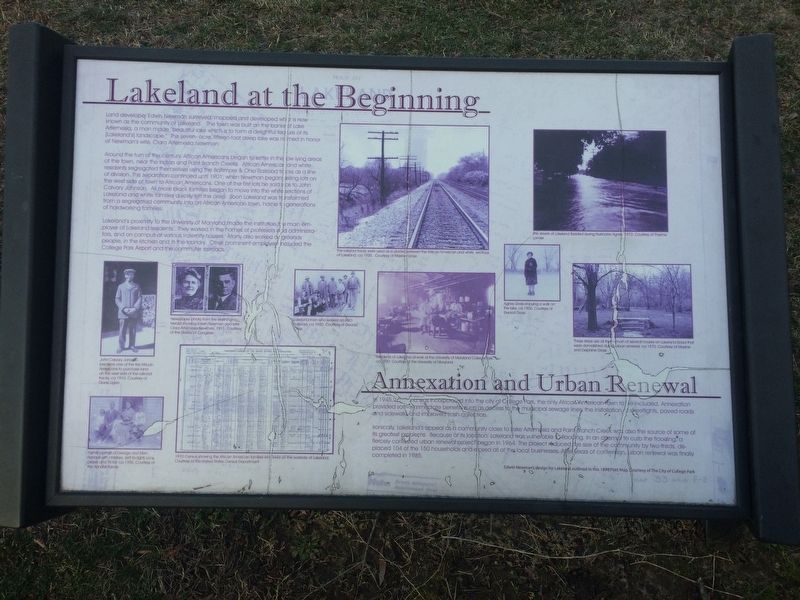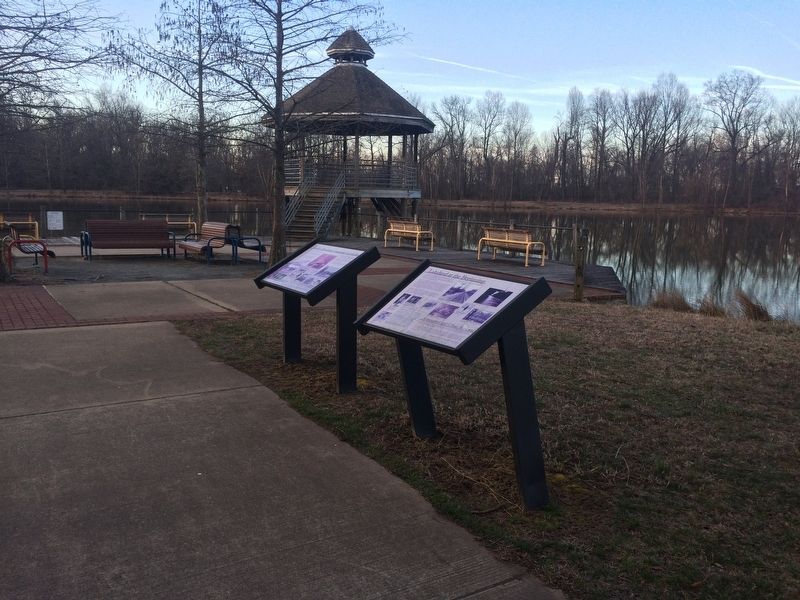College Park in Prince George's County, Maryland — The American Northeast (Mid-Atlantic)
Lakeland at the Beginning
Land developer Edwin Newman surveyed, mapped and developed what is now known as the community of Lakeland. The town was built on the banks of Lake Artemesia, a man made "beautiful lake which is to form a delightful feature of its [Lakeland's] landscape." The seven- acre, fifteen-foot deep lake was named in honor of Newman's wife, Clara Artemesia Newman.
Around the turn of the century, African Americans began to settle in the low lying areas of the town, near the Indian and Paint Branch Creeks. African American and white residents segregated themselves using the Baltimore & Ohio Railroad tracks as a line of division. The separation continued until 1901, when Newman began selling lots of the west side of town to African Americans. One of the first lots he sold was John Calvary Johnson. As more black families began to move into the white sections of Lakeland and white families quickly fled the area. Soon Lakeland was transformed from a segregated community into an African American town, home to generations of hardworking families.
Lakeland's proximity to the University of Maryland made the institution the main employer of Lakeland residents. They worked in the homes of professors and administrators, and on campus at various fraternity houses. Many also worked as grounds people, in the kitchen and in the laundry. Other prominent employers included the College Park Airport and the commuter railroads.
Annexation and Urban Renewal
In 1945, Lakeland was incorporated into the city of College Park, the only African American town to be included. Annexation provided some immediate benefits such as access to the municipal sewage lines, the installation of streetlights, paved roads and sidewalks, and improved trash collection.
Ironically, Lakeland's appeal as a community close to Lake Artemesia and Paint Branch Creek was also the source of some of its greatest problems Because of its location, Lakeland was vulnerable to flooding. In an attempt to curb the flooding, a fiercely contested urban renewal project began in 1964. The project reduced the size of the community by two-thirds, displaced 104 of the 150 households and closed all of the local businesses. After years of contention, urban renewal was finally completed in 1985.
[Captions:]
The railroad tracks were used as a divider between the African American and white sections of Lakeland, ca 1930. Courtesy of Maxine Gross
The streets of Lakeland flooded during Hurricane Agnes, 1972. Courtesy of Thelma Lomax
Agnes Gross enjoying a walk on the lake, ca 1950. Courtesy of Elwood Gross
John Calvary Johnson became one of the first African Americans
Newspaper photo from the Washington Herald showing Edwin Newman and wife Clara Artemesia Newman, 1911. Courtesy of the Library of Congress
These steps are all that remain of several houses on Lakeland Road that were demolished during urban renewal, ca 1970. Courtesy of Maxine and Delphine Gross
Lakeland men who worked on B&O Railroad, ca 1920. Courtesy of Elwood Gross
Residents of Lakewood at work at the University of Maryland College Park, ca 1920. Courtesy of the University of Maryland
1910 Census showing the African American families who lived on the eastside of Lakeland. Courtesy of the United States Census Department
Family portrait of George and Ellen Randall with children, (left to right) Lucy, Dessie and Victor, ca 1900. Courtesy of the Randall Family
Edwin Newman's design for Lakeland outlined in this 1890 Platt Map. Courtesy of The City of College Park
Topics. This historical marker is listed in these topic lists: African Americans • Railroads & Streetcars • Settlements & Settlers • Waterways & Vessels. A significant historical year for this entry is 1901.
Location. 38° 59.086′ N, 76° 55.273′ W. Marker is in College Park, Maryland, in Prince George's County. Marker is on Lake Artemesia Trail west of Luther Goldman Birding Trail, on the left when traveling north. On the grounds of Lake Artemesia Park. Touch for map. Marker is at or near this postal address: 5519 Cleveland Avenue, College Park MD 20740, United States of America. Touch for directions.
Other nearby markers. At least 8 other markers are within walking distance of this marker. Family, Church and Community in Lakeland (here, next to this marker); Origins of Lake Artemesia (approx. 0.3 miles away); College Park Airport (approx. 0.4 miles away); a different marker also named College Park Airport (approx. 0.4 miles away); Dervey Augusta Lomax (approx. 0.4 miles away); Arthur "Al" Welsh, 1881-1912: Pioneer Aviator (approx. 0.4 miles away); The Berwyn Heights Company (approx. 0.4 miles away); Flying the Mail (approx. 0.4 miles away). Touch for a list and map of all markers in College Park.
Credits. This page was last revised on April 1, 2024. It was originally submitted on March 17, 2018, by Devry Becker Jones of Washington, District of Columbia. This page has been viewed 301 times since then and 28 times this year. Photos: 1, 2. submitted on March 17, 2018, by Devry Becker Jones of Washington, District of Columbia. • Bill Pfingsten was the editor who published this page.

